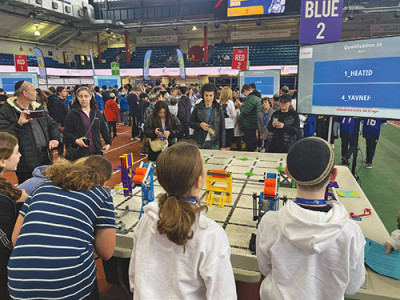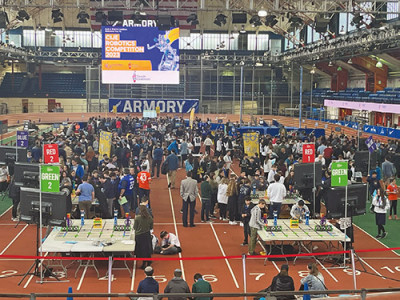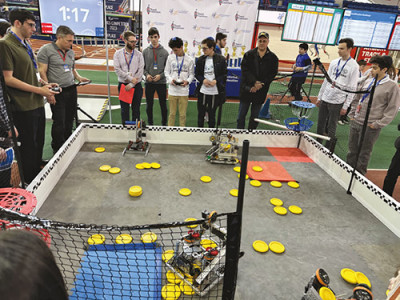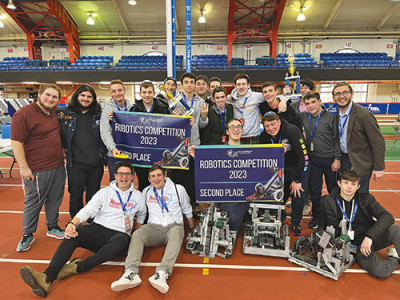
Hundreds of students representing more than 40 schools competed across three divisions in the recent CIJE Vex Robotics Tournament at the Fort Washington Armory in Washington Heights.
Vex Robotics is an international company that designs robotics competitions for students all over the world. With a different game for each division (elementary school, middle school and high school) every year, Vex is the standard in robotics competitions, a rapidly growing area of STEAM activities in schools across the globe.
Due to most Vex tournaments being held over weekends (and therefore over Shabbat), competing is an issue in the Jewish community. That’s where the Center for Initiatives in Jewish Education (CIJE) steps in to make amazing events like this one possible.

Created in 2001, CIJE coordinates educational programs in more than 175 Jewish schools across the country. Those programs impact the learning of more than 45,000 students each year and focus on both the ever-relevant (collaborating in teams, developing critical thinking skills and finding solutions) and the futuristic (the STEAM component). According to the organization, the goal is to prepare the next generation for innovation by funding programs with advanced technology, developing engaging curricula, and providing ongoing teacher training, mentorship and school visits by engineers.
In this case, they invited teams ranging from elementary to high school, from community to single-sex schools, and from local to out of town (Baltimore, Chicago, Miami, Dallas), to compete at this event. But CIJE actually does more than that. They supply the schools with the materials to build the games as per the specifications that Vex sends out. This allows the schools to have a playing field for the students to practice on that they have access to during the year.
The CIJE Robotics League challenges students to work in teams throughout the school year to build robots that compete in multi-school tournaments, culminating at this event. Students learn advanced programming, mechanical building, teamwork and problem-solving through the process of building their robots and competing.
The elementary school division was a pilot program for CIJE this year. While only a few schools were able to compete, it was a big success. Fourth and fifth graders competed in a complicated challenge based on a storyline taking place on Mars. Their robots scored points for doing things such as clearing debris from a landing pad, moving a shuttle to launch position, adjusting the angle of solar panels, and more.

If that sounds complicated, it is. And that’s kind of the idea. In the time allotted to them, the teams can’t possibly accomplish all the goals. With that being the case, they have to strategize to determine which challenges are worth the effort in order for their team to score the most points. At that point, they design their robot to fit their desired strategy.
The middle school division had a cooperative format where two teams competed with each other and both received whatever score they were able to accomplish together. In this case, teamwork was really on display. Not only did the teams have to cooperate to build a robot before the event, they had to learn to work alongside a random team in each round to score as many points as possible.
The middle school teams were tasked with releasing discs and moving them to an area where they could be slid under a bar into a scoring zone. But with the scoring zones being worth 1-2-3-4-1 points the farther away they were, the robots had to be able to send the discs far, but not too far. The teamwork aspect was clearly important as the scores later in the day greatly outpaced those from early on.
“This was an amazing experience,” said Eitan Goldsmith of Teaneck (eighth grade, Yavneh Academy), whose team finished second. “It’s awesome to do so well after all the effort we put in all year.”
At Yavneh, the robotics teams devote their elective period (once a week) and two hours after school each week to the program. As substantial as that is, the high schoolers invest even more time. TABC STEM Coordinator Aryeh Tiefenbrunn said that his teams meet during their school club hour, a mutually agreed upon lunch period, and pretty frequently after school. This totals as much as five hours per week as they approach a competition.

The high school division was the only one where the robots were really directly competing with each other. Yet even then, they were doing so in a two-on-two format. This required the teams to work together in order to defeat their opponents who were doing the same. With bigger robots, this arena was on the floor instead of on a tabletop like the other two.
With greater robotics experience, the challenges were greater. Not only were teams working against each other in the arena, the game was designed to make teams decide what point scoring ventures were worth the risk. The main part of the competition featured discs for the robots to launch into a basket that was around two feet off the ground. While this would have been difficult enough, the opposing team had a scoring zone on the ground below, meaning that if you missed your basket, you would be scoring points for your opponent.
Some teams decided not to even try to launch discs towards their basket and just push discs towards their scoring zones on the ground. Others decided to push discs out of their opponents’ scoring zones. In addition, there were other mechanisms in the arena that could be triggered to score points, and other teams focused on those. Strategies were endless, and the teams that succeeded were those who had a strong gameplan in addition to a good design.
“It was a lot of fun to drive the robot,” said Amitai Macklin (11th grade) of Teaneck, the driver for the second place TABC team. “We did a lot of work and it’s a lot of pressure, but coming to this competition makes everything worth it.”
Many schools actually had so much interest that they brought multiple teams. And while there was certainly a lot of fun going on, it was healthy competition as well. Mazel Day School from Brooklyn had their students wearing actual jerseys that they made for the robotics team. Other schools featured organized chants just before they started their rounds.

“Competitive sports create teamwork, but in robotics, a team creates one competitive robot,” said Orly Nadler, CIJE’s director of innovation. “A robot that can shoot projectiles into a basket, turn rollers, spin towers, knock down and lift up game pieces … can be strategized in multiple ways. This rich experience that fuses mechanics, coding, and design has been much more widely experienced by Jewish day schools due to the CIJE Robotics league. We are seeing wide embrace and enthusiasm for robotics from schools across the religious spectrum in Jewish day schools.”
With STEM options increasing in schools everywhere, CIJE’s role to help facilitate corresponding growth in Jewish day schools is greater than ever. Their goal is to be there for whatever is next for the future in STEM education and events like these demonstrate how happy the students are that CIJE is there to help them expand their educational horizons.
Nati Burnside is a freelance writer living in Fair Lawn and is a man of many interests. He can be reached at [email protected].













